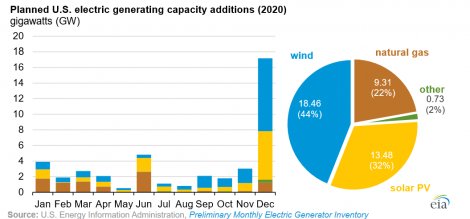Why Wind is a Safe Bet
 | Holly Fritz, Communications/Policy Associate |

 | Holly Fritz, Communications/Policy Associate |
Wind is more than
just a clean energy resource, it’s a great investment according to the 2018
Wind Technologies Market Report
from The Department of Energy. The analysis shows that costs to build
and operate wind farms are so low, it would be cheaper than the expected cost
of buying fuel for an equivalent natural gas plant. Wind prices have
declined 69 percent since 2009, making it the cheapest energy source of the
2010s. This record low is projected to have a long-term value that might
provide as a “hedge” against unpredictable natural gas prices.
since 2009, making it the cheapest energy source of the
2010s. This record low is projected to have a long-term value that might
provide as a “hedge” against unpredictable natural gas prices.
Fossil fuels not only pose an environmental risk, but a financial one as well. Because wind has no fuel cost, Power Purchase Agreements (PPA) can be locked in at a set price for many years, providing the certainty that businesses and utilities are looking for. Conversely, fossil fuel costs can fluctuate greatly, making it difficult to accurately forecast. This unpredictability makes for a trickier investment.
The Department of Energy’s analysis also found that wind power purchase agreement prices are at historic lows. The national average levelized price of wind PPAs has dropped to below $20 per megawatt hour (MWh). Today’s PPA prices are the results of a combination of higher capacity factors, declining installation and operating costs and low interest rates.
Even with advancements in wind technology in recent years, wind hardware prices continue to be affordable to install and operate. Turbine prices have dropped nearly 50 percent since 2008, despite new designs and advancements that increase the typical power output. That means that turbines are producing larger amounts of energy faster than ever without breaking the bank!

The United States just hit the 100 gigawatt (GW) mark for wind capacity in 2019, and this is expected to increase to 125 GW in 2020 with more projects and repowering in the works. That’s 44 percent of planned electric generation capacity additions for the year.
Rural communities, especially in the Midwest, are benefitting immensely from the renewable energy developments that provide well-paying jobs and economic development to their communities. Wind farms provide a source of new tax revenue for counties and townships, which is often used to help pay for road and bridge improvements, emergency services, schools and teacher salaries, as well as to reduce taxes.
Wind energy is a safe, affordable, and reliable energy source that offers financial prosperity for rural communities and helps meet our energy needs and carbon reduction goals. With no fuel cost, there’s less financial risk for utilities and their customers. Wind energy is a smart choice for small towns and corporate investors alike.